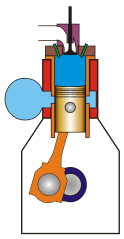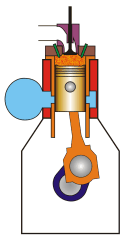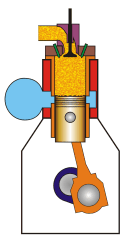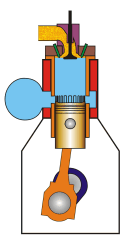The two-stroke Diesel engine does not mix fuel or oil with the combustion air. The crankshaft bearings are lubricated from pressurized oil in the same way as a four-stroke engine.
The two-stroke cycle is so called because it takes two strokes of the piston to complete the processes needed to convert the energy in the fuel into work. Because the engine is reciprocating, this means that the piston must move up and down the cylinder, and therefore the crankshaft must revolve once.
Working Cycle
1. The crankshaft is revolving clockwise and the piston is moving up the cylinder, compressing the charge of air. Because energy is being transferred into the air, its pressure and temperature increase. By the time the piston is approaching the top of the cylinder (known as Top Dead Center or TDC) the pressure is over 100 bar and the temperature over 500°C

2. Just before TDC fuel is injected into the cylinder by the fuel injector. The fuel is "atomised" into tiny droplets. Because they are very small these droplets heat up very quickly and start to burn as the piston passes over TDC. The expanding gas from the fuel burning in the oxygen forces the piston down the cylinder, turning the crankshaft. It is during this stroke that work energy is being put into the engine; during the upward stroke of the piston, the engine is having to do the work.

3. As the piston moves down the cylinder, the useful energy from the burning fuel is expended. At about 110° after TDC the exhaust valve opens and the hot exhaust gas (consisting mostly of nitrogen, carbon dioxide, water vapour and unused oxygen) begin to leave the cylinder.

4. At about 140º after TDC the piston uncovers a set of ports known as scavenge ports. Pressurised air enters the cylinder via these ports and pushes the remaining exhaust gas from the cylinder in a process known as "scavenging".
The piston now goes past Bottom Dead Centre and starts moving up the cylinder, closing off the scavenge ports. The exhaust valve then closes and compression begins.
